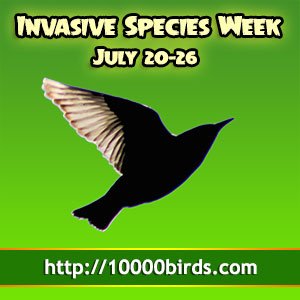
This is not the week for a xenophobic birder. Here at 10,000 Birds we are going to dedicate the coming week, from today until Saturday, to invasive species. We plan to use the broadest possible definition of invasive species, including species that are expanding under their own power and even species that are not, to the best of our knowledge, causing harm to species native in the range into which the invaders are expanding.
Of course, most of the species we will cover will fit the more traditional definition of invasive species, which usually only covers introduced species that are doing harm to species in the areas to which they are introduced. (For a pretty good idea of the different definitions of invasive species check out the definitions Wikipedia provides.)
But why are we covering invasive species at all? One reason is that the topic is broad and fascinating. As organisms move into ecosystems where they haven’t occurred it is very difficult to figure out what will happen in advance. Will native species suffer? Will the invader prosper? Will there be cascading effects from either of those outcomes? The dynamic nature of invasive species makes them a subject worthy of examining from a multitude of angles and that is what we are going to do during Invasive Species Week.
We will have posts covering invasive species across a wide geographical range, from New Zealand to North America. We will cover mammals, plants, and, of course, birds. The sheer number of invasive species over the last several hundred years means that we can’t hope to be exhaustive in our coverage but I think we will have a nice survey of different topics.
As it says in our Invasive Species Week footer, batten down the hatches, strap on your helmet, and prepare to be invaded! This is going to be a heck of a ride!
…
 Here at 10,000 Birds 20 July – 26 July is Invasive Species Week. We use the term “Invasive Species” in the broadest sense, to encompass those invasive species that have expanded beyond their historical ranges under their own power, by deliberate introduction, or by unintentional introduction. The sheer number of species that have been shuffled around on our big earth is impressive, though we will be dealing with the smaller sample size of invasive avians and other invasives that effect avians. Nonetheless, this week will be chock full of invasive species. So batten down the hatches, strap on your helmet, and prepare to be invaded! To access the entire week’s worth of content just click here.
Here at 10,000 Birds 20 July – 26 July is Invasive Species Week. We use the term “Invasive Species” in the broadest sense, to encompass those invasive species that have expanded beyond their historical ranges under their own power, by deliberate introduction, or by unintentional introduction. The sheer number of species that have been shuffled around on our big earth is impressive, though we will be dealing with the smaller sample size of invasive avians and other invasives that effect avians. Nonetheless, this week will be chock full of invasive species. So batten down the hatches, strap on your helmet, and prepare to be invaded! To access the entire week’s worth of content just click here.













Congrats Corey on your success! I found this article a bit late but appreciated it as it gives attention to invasive birds. My company, Quick Catch, deals with invasive animals on a regular basis. We don’t deal with as many birds as snakes but there is the occasional need to handle the feathered friends. I personally find wild hogs being some of the outlandish invasive species as they are quick, smart and can cause a lot of damage in a short time.
Keep up the great work!